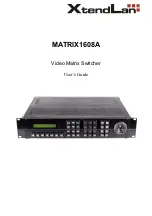
486
or routing purposes. ICMP messages generally contain information about routing difficulties or simple exchanges such
as time-stamp or echo transactions. For example, the PING command uses ICMP to test an Internet connection.
IEEE 802.1X
IEEE 802.1X is an IEEE standard for port-based Network Access Control. It provides authentication to devices attached
to a LAN port, establishing a point-to-point connection or preventing access from that port if authentication fails. With
802.1X, access to all switch ports can be centrally controlled from a server, which means that authorized users can use
the same credentials for authentication from any point within the network.
IGMP
IGMP is an acronym for
I
nternet
G
roup
M
anagement
P
rotocol. It is a communications protocol used to manage the
membership of Internet Protocol multicast groups. IGMP is used by IP hosts and adjacent multicast routers to establish
multicast group memberships. It is an integral part of the IP multicast specification, like ICMP for unicast connections.
IGMP can be used for online video and gaming, and allows more efficient use of resources when supporting these uses.
IGMP Querier
A router sends IGMP Query messages onto a particular link. This router is called the Querier.
IMAP
IMAP is an acronym for
I
nternet
M
essage
A
ccess
P
rotocol. It is a protocol for email clients to retrieve email messages
from a mail server.
IMAP is the protocol that IMAP clients use to communicate with the servers, and SMTP is the protocol used to transport
mail to an IMAP server.
The current version of the Internet Message Access Protocol is IMAP4. It is similar to Post Office Protocol version 3
(POP3), but offers additional and more complex features. For example, the IMAP4 protocol leaves your email
messages on the server rather than downloading them to your computer. If you wish to remove your messages from the
server, you must use your mail client to generate local folders, copy messages to your local hard drive, and then delete
and expunge the messages from the server.
IP
IP is an acronym for
I
nternet
P
rotocol. It is a protocol used for communicating data across a internet network.
IP is a "best effort" system, which means that no packet of information sent over it is assured to reach its destination in
the same condition it was sent. Each device connected to a Local Area Network (LAN) or Wide Area Network (WAN) is
given an Internet Protocol address, and this IP address is used to identify the device uniquely among all other devices
connected to the extended network.
The current version of the Internet protocol is IPv4, which has 32-bits Internet Protocol addresses allowing for in excess
of four billion unique addresses. This number is reduced drastically by the practice of webmasters taking addresses in
large blocks, the bulk of which remain unused. There is a rather substantial movement to adopt a new version of the
Internet Protocol, IPv6, which would have 128-bits Internet Protocol addresses. This number can be represented
roughly by a three with thirty-nine zeroes after it. However, IPv4 is still the protocol of choice for most of the Internet.
Summary of Contents for IFS NS3550-24T/4S
Page 1: ...P N 1072569 REV 00 05 ISS 11OCT12 IFS NS3550 24T 4S User Manual ...
Page 37: ...User s Manual of NS3550 24T 4S 37 ...
Page 96: ...96 Figure 4 4 6 Port Mirror Configuration Page Screenshot ...
Page 127: ...User s Manual of NS3550 24T 4S 127 Figure 4 6 10 Port 1 Port 6 VLAN Configuration ...
Page 184: ...184 Figure 4 9 14 Voice VLAN Configuration Page Screenshot ...
Page 204: ...204 Figure 4 11 4 Network Access Server Configuration Page Screenshot ...
Page 234: ...234 Figure 4 12 1 Port Limit Control Configuration Overview Page Screenshot ...
Page 250: ...250 Click to undo any changes made locally and revert to previously saved values ...
Page 297: ...User s Manual of NS3550 24T 4S 297 ...
Page 388: ...388 Example Show RADIUS statistics SWITCH security aaa statistics ...
Page 410: ...410 Parameters vid VLAN ID 1 4095 Default Setting disable ...













































